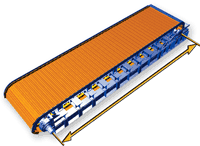Plate Feeder Classification
The current range of MMD Heavy Duty Apron Plate Feeders are classified from D4 to D11 with various widths and lengths available. Below are the characteristics of an MMD feeder, which identify its design.
Chains and RollersThe main designation of a feeder are the heavy duty chains and rollers which are attached to the main frame. The chains and rollers vary in size depending on the application and stresses they will be put under. Chains and rollers are manufactured by caterpillar and designated as D4, D7, D9 and D11 chain and rollers, the higher the 'D' number the greater the intensity of the work load. Subsequently a feeder is initially categorised as D4, D7, D9 or D11 plate feeder. |
|
Plate WidthThe Apron Plates which are fixed to the chain are made from especially rolled sections and are manufactured in various widths, to cater for the maximum volume of material which may need to be processed. Standard widths available are 1500, 2000, 3000 and 4000mm. |
|
Feeder LengthThe feeder length is measured from the centre-line of the tail sprocket to the centre-line of the head sprocket. This is a distance of how far material needs to travel to reach the designated point from the loading area. |
|
DriveThe drive located at the head sprocket is generally a variable speed unit as it is often the main method of controlling the throughput of the plant. There are two types of variable speed drive available, electromechanical and hydraulic, depending on the source of energy. |
|
Fines Retrieval SystemAn optional extra is the fines retrieval system, which is positioned underneath the feeder to prevent fine material from spilling underneath the feeder. |
|
Source: http://www.mmdsizers.com/products/feeder/range/desfeeder.php

|





